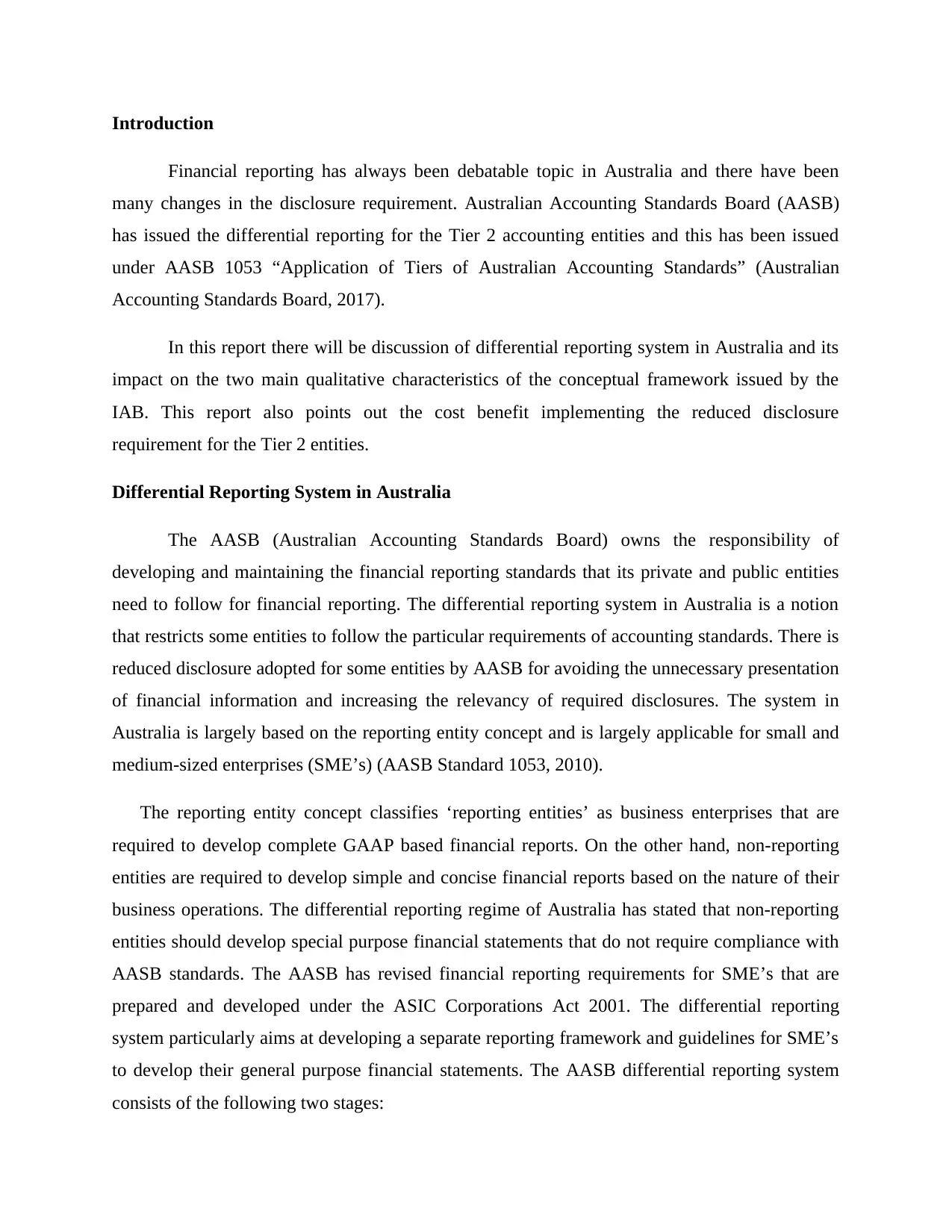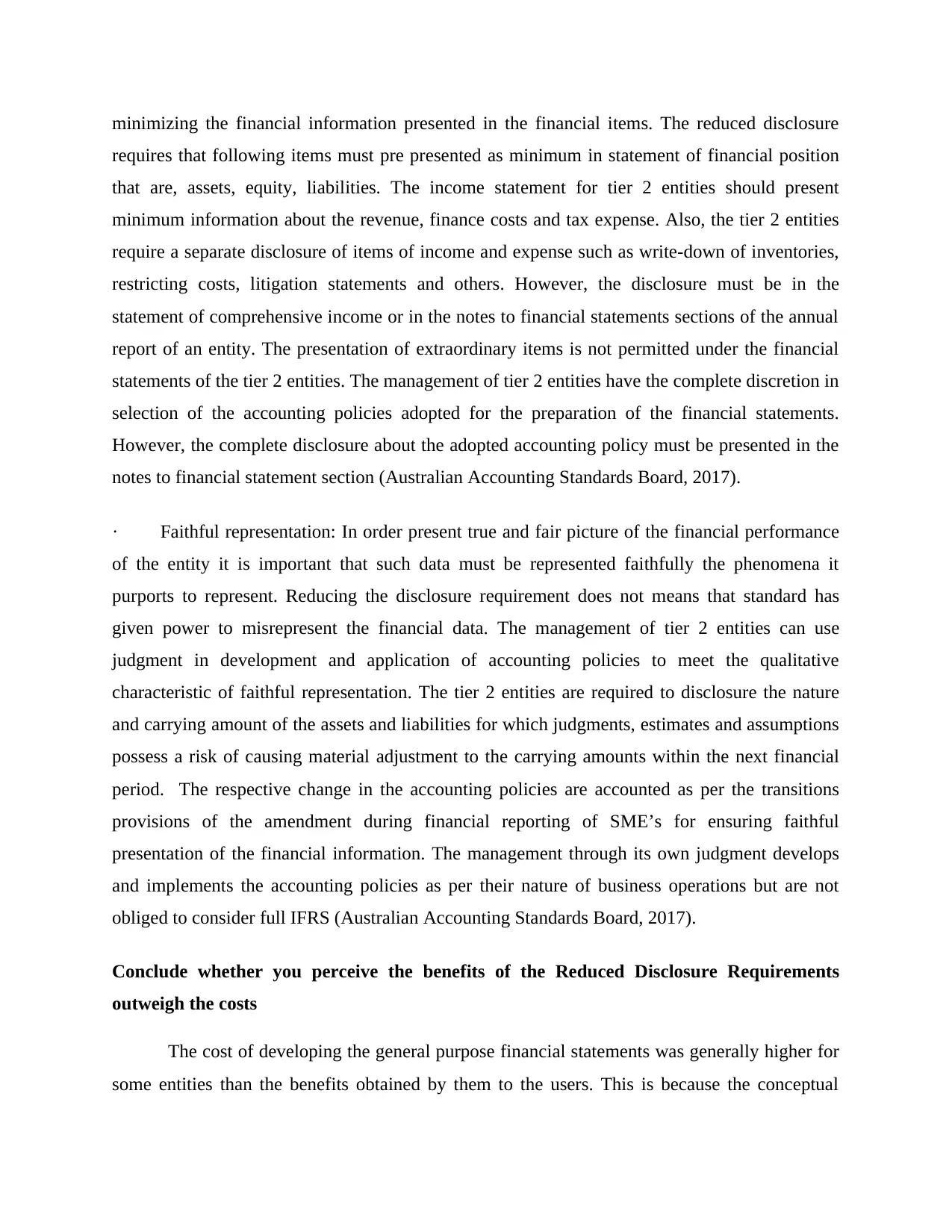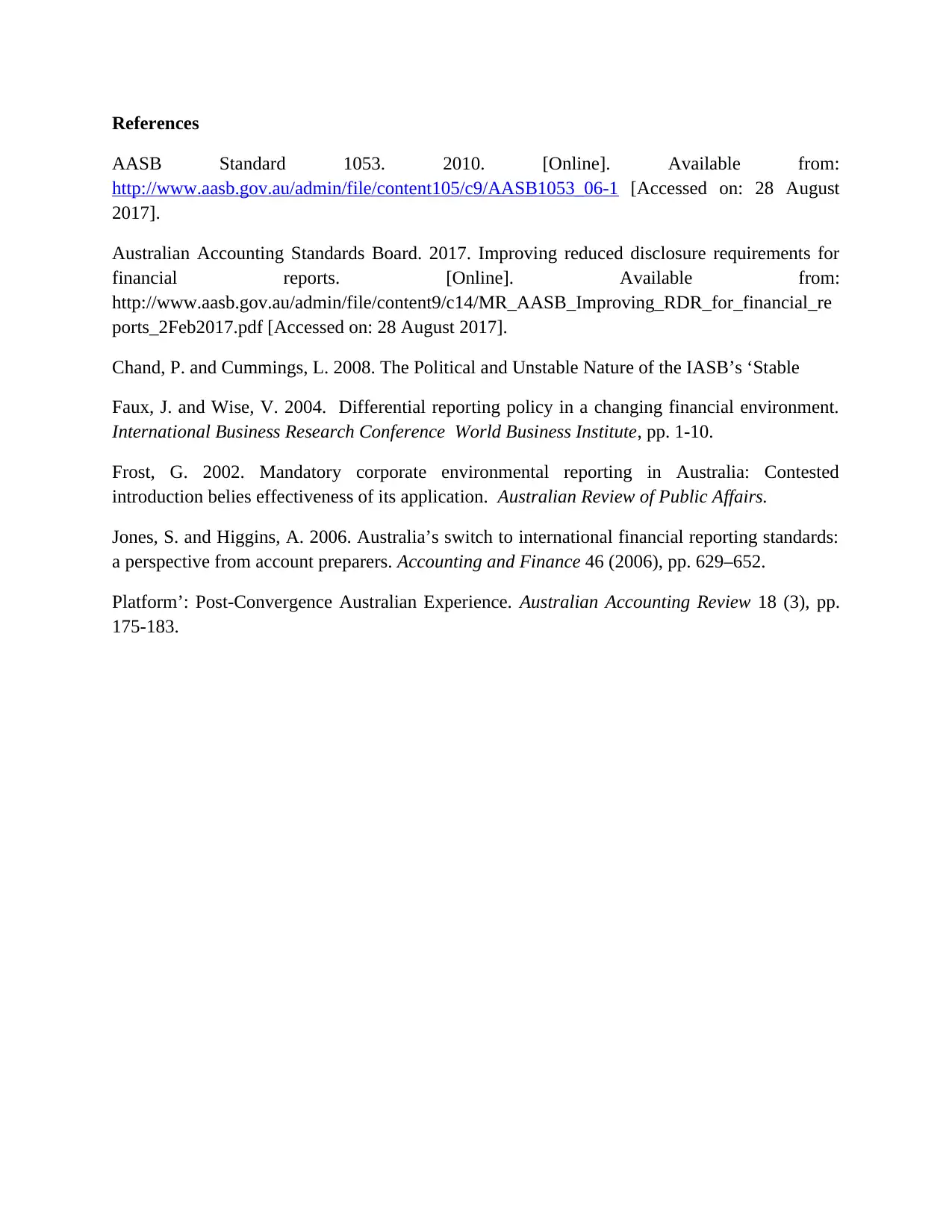Australia's Differential Reporting System: An Analysis
VerifiedAdded on 2020/02/24
|6
|1547
|36
Report
AI Summary
This report examines the differential reporting system in Australia, focusing on the guidelines issued by the Australian Accounting Standards Board (AASB) under AASB 1053. It discusses the reduced disclosure requirements for Tier 2 accounting entities and analyzes their impact on the qualitative characteristics of financial information, such as relevance and faithful representation, as defined by the conceptual framework of IFRS. The report explores the cost-benefit analysis of implementing these reduced disclosure requirements, considering the burden on small and medium-sized enterprises (SMEs). It highlights the key changes in disclosure for Tier 2 entities, including the minimum information required in financial statements and the discretion given to management in selecting accounting policies. The report concludes that the benefits of reduced disclosure outweigh the costs, providing a simplified reporting structure for SMEs while maintaining the quality of financial information.

Accounting
Paraphrase This Document
Need a fresh take? Get an instant paraphrase of this document with our AI Paraphraser

Introduction
Financial reporting has always been debatable topic in Australia and there have been
many changes in the disclosure requirement. Australian Accounting Standards Board (AASB)
has issued the differential reporting for the Tier 2 accounting entities and this has been issued
under AASB 1053 “Application of Tiers of Australian Accounting Standards” (Australian
Accounting Standards Board, 2017).
In this report there will be discussion of differential reporting system in Australia and its
impact on the two main qualitative characteristics of the conceptual framework issued by the
IAB. This report also points out the cost benefit implementing the reduced disclosure
requirement for the Tier 2 entities.
Differential Reporting System in Australia
The AASB (Australian Accounting Standards Board) owns the responsibility of
developing and maintaining the financial reporting standards that its private and public entities
need to follow for financial reporting. The differential reporting system in Australia is a notion
that restricts some entities to follow the particular requirements of accounting standards. There is
reduced disclosure adopted for some entities by AASB for avoiding the unnecessary presentation
of financial information and increasing the relevancy of required disclosures. The system in
Australia is largely based on the reporting entity concept and is largely applicable for small and
medium-sized enterprises (SME’s) (AASB Standard 1053, 2010).
The reporting entity concept classifies ‘reporting entities’ as business enterprises that are
required to develop complete GAAP based financial reports. On the other hand, non-reporting
entities are required to develop simple and concise financial reports based on the nature of their
business operations. The differential reporting regime of Australia has stated that non-reporting
entities should develop special purpose financial statements that do not require compliance with
AASB standards. The AASB has revised financial reporting requirements for SME’s that are
prepared and developed under the ASIC Corporations Act 2001. The differential reporting
system particularly aims at developing a separate reporting framework and guidelines for SME’s
to develop their general purpose financial statements. The AASB differential reporting system
consists of the following two stages:
Financial reporting has always been debatable topic in Australia and there have been
many changes in the disclosure requirement. Australian Accounting Standards Board (AASB)
has issued the differential reporting for the Tier 2 accounting entities and this has been issued
under AASB 1053 “Application of Tiers of Australian Accounting Standards” (Australian
Accounting Standards Board, 2017).
In this report there will be discussion of differential reporting system in Australia and its
impact on the two main qualitative characteristics of the conceptual framework issued by the
IAB. This report also points out the cost benefit implementing the reduced disclosure
requirement for the Tier 2 entities.
Differential Reporting System in Australia
The AASB (Australian Accounting Standards Board) owns the responsibility of
developing and maintaining the financial reporting standards that its private and public entities
need to follow for financial reporting. The differential reporting system in Australia is a notion
that restricts some entities to follow the particular requirements of accounting standards. There is
reduced disclosure adopted for some entities by AASB for avoiding the unnecessary presentation
of financial information and increasing the relevancy of required disclosures. The system in
Australia is largely based on the reporting entity concept and is largely applicable for small and
medium-sized enterprises (SME’s) (AASB Standard 1053, 2010).
The reporting entity concept classifies ‘reporting entities’ as business enterprises that are
required to develop complete GAAP based financial reports. On the other hand, non-reporting
entities are required to develop simple and concise financial reports based on the nature of their
business operations. The differential reporting regime of Australia has stated that non-reporting
entities should develop special purpose financial statements that do not require compliance with
AASB standards. The AASB has revised financial reporting requirements for SME’s that are
prepared and developed under the ASIC Corporations Act 2001. The differential reporting
system particularly aims at developing a separate reporting framework and guidelines for SME’s
to develop their general purpose financial statements. The AASB differential reporting system
consists of the following two stages:

Stage 1: It involves the development of reduce disclosure requirements for small and
medium sized companies
Stage 2: It involves developing a revised differential reporting framework based on the
concept of reporting entity.
The main objective behind the development of this system is to simplify the disclosure,
measurement and recognition requirements for SME’s for reducing the burden and consequent
costs for them in developing financial reports (Chand and Cummings, 2008).
Impacts due to use of Reduced Disclosure Requirements on the qualitative characteristics
of the financial information represented by the Tier 2 entities in their financial statements
IFRS provides the conceptual framework that every entity has to follow in their disclosure
requirement of the financial information in the annual report. The conceptual framework
provides most important qualitative characteristics of the financial information that has been
adhered by the entities while making the financial disclosure in their reports. The fundamental
qualitative characteristics of the financial have been divided into two main types.
Relevance
Faithful Representation
The qualitative characteristics of the financial help the users of the financial report to easily
understand the annual report and make the decisions accordingly. Financial information can only
be useful if it is relevant and represented with true faith in timely manner. So to check the impact
of the reduced disclosure requirement for the Tier 2 entities on the qualitative characteristics of
financial information, let discuss the characteristics in detail and make comparison with the
disclosure changes made in the reduced disclosure:
Fundamental qualitative characteristics
· Relevance: Relevance financial information refers to such information that is user oriented
and has capability to change the decisions of the users. As per the conceptual framework relevant
financial information can make changes to the decision if it is predictive value, confirmative
value or both. As per the reduced disclosure requirement issued by the AASB, the financial
information must be concise to such extent that the user required data has been incorporated and
no compromise has been made in such respect. The reduced disclosure for SME’s has resulted in
medium sized companies
Stage 2: It involves developing a revised differential reporting framework based on the
concept of reporting entity.
The main objective behind the development of this system is to simplify the disclosure,
measurement and recognition requirements for SME’s for reducing the burden and consequent
costs for them in developing financial reports (Chand and Cummings, 2008).
Impacts due to use of Reduced Disclosure Requirements on the qualitative characteristics
of the financial information represented by the Tier 2 entities in their financial statements
IFRS provides the conceptual framework that every entity has to follow in their disclosure
requirement of the financial information in the annual report. The conceptual framework
provides most important qualitative characteristics of the financial information that has been
adhered by the entities while making the financial disclosure in their reports. The fundamental
qualitative characteristics of the financial have been divided into two main types.
Relevance
Faithful Representation
The qualitative characteristics of the financial help the users of the financial report to easily
understand the annual report and make the decisions accordingly. Financial information can only
be useful if it is relevant and represented with true faith in timely manner. So to check the impact
of the reduced disclosure requirement for the Tier 2 entities on the qualitative characteristics of
financial information, let discuss the characteristics in detail and make comparison with the
disclosure changes made in the reduced disclosure:
Fundamental qualitative characteristics
· Relevance: Relevance financial information refers to such information that is user oriented
and has capability to change the decisions of the users. As per the conceptual framework relevant
financial information can make changes to the decision if it is predictive value, confirmative
value or both. As per the reduced disclosure requirement issued by the AASB, the financial
information must be concise to such extent that the user required data has been incorporated and
no compromise has been made in such respect. The reduced disclosure for SME’s has resulted in
⊘ This is a preview!⊘
Do you want full access?
Subscribe today to unlock all pages.

Trusted by 1+ million students worldwide

minimizing the financial information presented in the financial items. The reduced disclosure
requires that following items must pre presented as minimum in statement of financial position
that are, assets, equity, liabilities. The income statement for tier 2 entities should present
minimum information about the revenue, finance costs and tax expense. Also, the tier 2 entities
require a separate disclosure of items of income and expense such as write-down of inventories,
restricting costs, litigation statements and others. However, the disclosure must be in the
statement of comprehensive income or in the notes to financial statements sections of the annual
report of an entity. The presentation of extraordinary items is not permitted under the financial
statements of the tier 2 entities. The management of tier 2 entities have the complete discretion in
selection of the accounting policies adopted for the preparation of the financial statements.
However, the complete disclosure about the adopted accounting policy must be presented in the
notes to financial statement section (Australian Accounting Standards Board, 2017).
· Faithful representation: In order present true and fair picture of the financial performance
of the entity it is important that such data must be represented faithfully the phenomena it
purports to represent. Reducing the disclosure requirement does not means that standard has
given power to misrepresent the financial data. The management of tier 2 entities can use
judgment in development and application of accounting policies to meet the qualitative
characteristic of faithful representation. The tier 2 entities are required to disclosure the nature
and carrying amount of the assets and liabilities for which judgments, estimates and assumptions
possess a risk of causing material adjustment to the carrying amounts within the next financial
period. The respective change in the accounting policies are accounted as per the transitions
provisions of the amendment during financial reporting of SME’s for ensuring faithful
presentation of the financial information. The management through its own judgment develops
and implements the accounting policies as per their nature of business operations but are not
obliged to consider full IFRS (Australian Accounting Standards Board, 2017).
Conclude whether you perceive the benefits of the Reduced Disclosure Requirements
outweigh the costs
The cost of developing the general purpose financial statements was generally higher for
some entities than the benefits obtained by them to the users. This is because the conceptual
requires that following items must pre presented as minimum in statement of financial position
that are, assets, equity, liabilities. The income statement for tier 2 entities should present
minimum information about the revenue, finance costs and tax expense. Also, the tier 2 entities
require a separate disclosure of items of income and expense such as write-down of inventories,
restricting costs, litigation statements and others. However, the disclosure must be in the
statement of comprehensive income or in the notes to financial statements sections of the annual
report of an entity. The presentation of extraordinary items is not permitted under the financial
statements of the tier 2 entities. The management of tier 2 entities have the complete discretion in
selection of the accounting policies adopted for the preparation of the financial statements.
However, the complete disclosure about the adopted accounting policy must be presented in the
notes to financial statement section (Australian Accounting Standards Board, 2017).
· Faithful representation: In order present true and fair picture of the financial performance
of the entity it is important that such data must be represented faithfully the phenomena it
purports to represent. Reducing the disclosure requirement does not means that standard has
given power to misrepresent the financial data. The management of tier 2 entities can use
judgment in development and application of accounting policies to meet the qualitative
characteristic of faithful representation. The tier 2 entities are required to disclosure the nature
and carrying amount of the assets and liabilities for which judgments, estimates and assumptions
possess a risk of causing material adjustment to the carrying amounts within the next financial
period. The respective change in the accounting policies are accounted as per the transitions
provisions of the amendment during financial reporting of SME’s for ensuring faithful
presentation of the financial information. The management through its own judgment develops
and implements the accounting policies as per their nature of business operations but are not
obliged to consider full IFRS (Australian Accounting Standards Board, 2017).
Conclude whether you perceive the benefits of the Reduced Disclosure Requirements
outweigh the costs
The cost of developing the general purpose financial statements was generally higher for
some entities than the benefits obtained by them to the users. This is because the conceptual
Paraphrase This Document
Need a fresh take? Get an instant paraphrase of this document with our AI Paraphraser

framework was very burdensome for small and medium-sized companies who have small scale
business operations. The adopted RDR framework has the objective that its benefits should
outweigh the costs. The RDR is providing the benefit of improving the relevancy of financial
reporting if SME’s through reducing the disclosure requirements and removing the unnecessary
disclosures on the part of some entities. Thus, it helps in achieving a good balance between the
efforts of the developer and the needs of end-users (Jones and Higgins, 2006). Also, the RDR
framework has helped in simplifying the reporting structure of small entities thus improving the
transparency and comparability of the financial information disclosed by them in the special
purpose financial reports. The reduce disclosure around the financial instruments ensures that the
financial reports developed are not too detailed and seeks interest from the end-users (Faux and
Wise, 2004).
Conclusion
Through analyzing all the above information about the reduced disclosure requirement it
can be said that there is no big impact on the qualitative characteristics of the financial
information and also it is cost beneficial to use this approach.
business operations. The adopted RDR framework has the objective that its benefits should
outweigh the costs. The RDR is providing the benefit of improving the relevancy of financial
reporting if SME’s through reducing the disclosure requirements and removing the unnecessary
disclosures on the part of some entities. Thus, it helps in achieving a good balance between the
efforts of the developer and the needs of end-users (Jones and Higgins, 2006). Also, the RDR
framework has helped in simplifying the reporting structure of small entities thus improving the
transparency and comparability of the financial information disclosed by them in the special
purpose financial reports. The reduce disclosure around the financial instruments ensures that the
financial reports developed are not too detailed and seeks interest from the end-users (Faux and
Wise, 2004).
Conclusion
Through analyzing all the above information about the reduced disclosure requirement it
can be said that there is no big impact on the qualitative characteristics of the financial
information and also it is cost beneficial to use this approach.

References
AASB Standard 1053. 2010. [Online]. Available from:
http://www.aasb.gov.au/admin/file/content105/c9/AASB1053_06-1 [Accessed on: 28 August
2017].
Australian Accounting Standards Board. 2017. Improving reduced disclosure requirements for
financial reports. [Online]. Available from:
http://www.aasb.gov.au/admin/file/content9/c14/MR_AASB_Improving_RDR_for_financial_re
ports_2Feb2017.pdf [Accessed on: 28 August 2017].
Chand, P. and Cummings, L. 2008. The Political and Unstable Nature of the IASB’s ‘Stable
Faux, J. and Wise, V. 2004. Differential reporting policy in a changing financial environment.
International Business Research Conference World Business Institute, pp. 1-10.
Frost, G. 2002. Mandatory corporate environmental reporting in Australia: Contested
introduction belies effectiveness of its application. Australian Review of Public Affairs.
Jones, S. and Higgins, A. 2006. Australia’s switch to international financial reporting standards:
a perspective from account preparers. Accounting and Finance 46 (2006), pp. 629–652.
Platform’: Post-Convergence Australian Experience. Australian Accounting Review 18 (3), pp.
175-183.
AASB Standard 1053. 2010. [Online]. Available from:
http://www.aasb.gov.au/admin/file/content105/c9/AASB1053_06-1 [Accessed on: 28 August
2017].
Australian Accounting Standards Board. 2017. Improving reduced disclosure requirements for
financial reports. [Online]. Available from:
http://www.aasb.gov.au/admin/file/content9/c14/MR_AASB_Improving_RDR_for_financial_re
ports_2Feb2017.pdf [Accessed on: 28 August 2017].
Chand, P. and Cummings, L. 2008. The Political and Unstable Nature of the IASB’s ‘Stable
Faux, J. and Wise, V. 2004. Differential reporting policy in a changing financial environment.
International Business Research Conference World Business Institute, pp. 1-10.
Frost, G. 2002. Mandatory corporate environmental reporting in Australia: Contested
introduction belies effectiveness of its application. Australian Review of Public Affairs.
Jones, S. and Higgins, A. 2006. Australia’s switch to international financial reporting standards:
a perspective from account preparers. Accounting and Finance 46 (2006), pp. 629–652.
Platform’: Post-Convergence Australian Experience. Australian Accounting Review 18 (3), pp.
175-183.
⊘ This is a preview!⊘
Do you want full access?
Subscribe today to unlock all pages.

Trusted by 1+ million students worldwide
1 out of 6
Related Documents
Your All-in-One AI-Powered Toolkit for Academic Success.
+13062052269
info@desklib.com
Available 24*7 on WhatsApp / Email
![[object Object]](/_next/static/media/star-bottom.7253800d.svg)
Unlock your academic potential
Copyright © 2020–2025 A2Z Services. All Rights Reserved. Developed and managed by ZUCOL.





